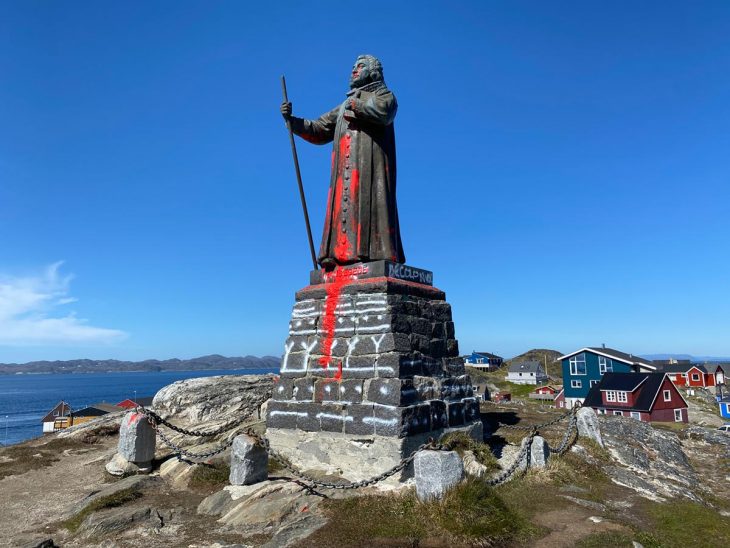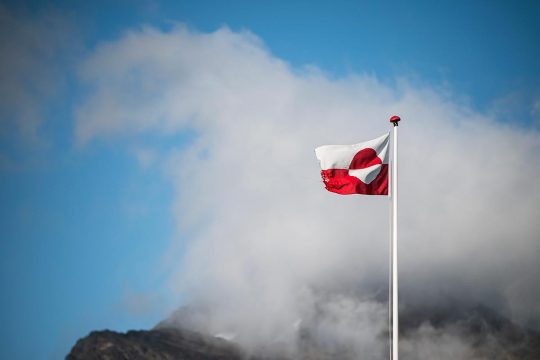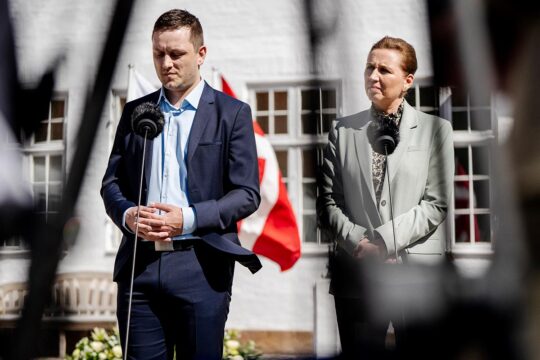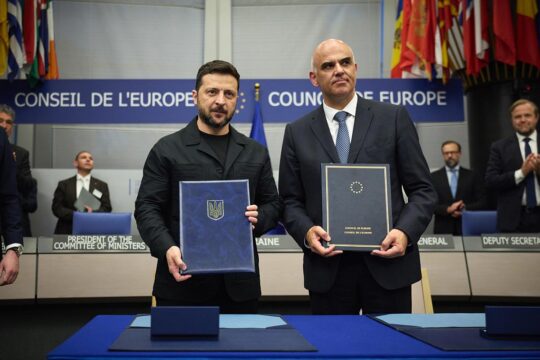On the morning of June 21, Greenland’s National Day, inhabitants in the capital Nuuk woke up to the statue of the missionary Hans Egede painted over with Inuit symbols, red paint on his face and the word “Decolonize” written on the plinth. However, the fate of the statue followed a somewhat different trajectory compared to other colonial statues around the world.
In August, after weeks of very intense public debate in Greenland following the action of activists on National Day, inhabitants in the municipality of which Nuuk is part, took a public vote on the matter and decided - perhaps surprisingly - that the statue should remain in place, towering high over the oldest part of Nuuk, still referred to as The Colonial Harbour.
Mental decolonization
It is a worldwide common practice to remove the iconography of the former reign after regime changes and/or the declaration of independence. In Greenland, a process of political decolonization has unfolded since the 1960s. Greenland obtained Home Rule in 1979. In 2009, the Act of Greenland Self-Government replaced Home Rule and recognized Greenlanders as a people pursuant to international law. Greenland remains part of the Kingdom of Denmark. However, Greenlandic authorities could well have removed the statue already back in 1979. The fact that the statue remains in place has made it an unintended symbol of a question that keeps surfacing in Greenland as part of the gradual transition towards greater degrees of sovereignty: Is a political/legal decolonization process aimed at ultimate Greenlandic state sovereignty enough, or is mental and epistemological decolonization a prerequisite to get there – and what does the latter entail?
This summer’s debate on the statue plunged right into this question, which also was one of the main themes occupying the Greenlandic Reconciliation Commission, established in 2014. And just as the Reconciliation Commission met staunch internal opposition in Greenland, so did activists in this latest round of debate.
A mixed symbol
The statue of Hans Egede has been in place for 98 years. It is a copy of an Egede statue in Copenhagen. It was erected in Nuuk a year after the commemorative celebrations of Egede’s arrival in Greenland in 1721, organized by the Danish colonial administration. However the funds came mainly from donations collected amongst Greenlanders and then donations from Danish churchgoers. The funding by both churchgoers and the colonial administration mirrors Egede’s double historical role as both the introducer of Christianity and of Danish state-sponsored colonialism.
Egede grew up in northern Norway in a time when Norway was controlled from Copenhagen. He believed that the “wild people” of Greenland, of whom he had heard from Norwegian whalers, might be either pagans, or the Catholic descendants of the Norsemen, who via Iceland had settled in the southern part of Greenland in the 10th century. Either way, they – in Egede’s view – needed to know the Lutheran version of Christianity.
Egede’s motivation was religious. Yet his initiative ended up having tremendous importance for the territorial claims of the Danish king.
For centuries, Danish kings had been unable to enforce sovereignty over Greenland, which they claimed belonged to Denmark from 1397 onwards, despite not setting foot there. The Inuit in Greenland only recognized themselves as the rightful inhabitants of the lands they would refer to as Inuit Nunaat (The Land of the People/the Human Beings), while the Greenlandic waters were dominated by Basque, British, and especially Dutch whalers.
All this changed dramatically on July 3, 1721 when Hans Egede first landed on an island not far from today’s Nuuk. Backed by the King of Denmark, his arrival became synonymous with the advent of the Danish state in Greenland, thus securing the state of Denmark-Norway new possibilities to claim sovereignty over the entire North Atlantic region.
Time to decolonize our minds
After the painting of the statue on National Day, Greenlandic producer and artist Aqqalu Berthelsen published a statement from the group of anonymous activists that had painted it. “It’s about time that we stop celebrating colonizers and that we start taking back what is rightfully ours. It is time to decolonize our minds and our country. No colonizer deserves to be on top of a mountain like that. We need to learn the Truth of our History,” the statement said.
The activists are part of a movement in Greenland calling for mental decolonization, who argue that despite large degrees of self-government compared to other indigenous peoples around the world, a wide variety of informal forms of colonialism are still governing Greenlandic people, making the transition away from the state of Denmark almost impossible.
In the intense and emotional debate that followed, several artists, bloggers, and cultural personalities expressed similar points of view. Many argued that the violence of Hans Egede himself and the structural violence caused by the introduction of Christianity and colonization had been glossed over to the degree that many Greenlanders have become unable to understand the link between historical events and today’s socio-economic problems troubling Greenland.
Amongst the more pragmatic, some argued for the removal of the statue to a less conspicuous place, nearer ground level, close to a church or at a museum. Others – inspired by the overthrow of the Colston statue in Bristol, UK – suggested that it should simply be thrown into the sea.
However, despite the fact that future Greenlandic independence remains a political ambition shared by the vast majority of Greenlanders, the decolonizing movement met strong resistance. Opposition seems to be grounded in a blend of generational differences, religion, and an insistence that Greenland today is a mix of indigenous and European culture, plus opposition to the idea of being mentally colonized.
Approximately 94% of Greenland’s population are Christian. Christian traditions are greatly valued by most and, especially amongst the older generations, Egede is often revered as the founder of the Greenlandic Church.
Should it stay or should it go?
Shortly after the painting of the Egede statue, two private petitions were initiated. One was led by college student Ria Sivertsen, who suggested that the statue be moved to the local historic museum. “It’s not about erasing history. But it’s a disparaging and humiliating symbol that he is still there on top of the hill and still possesses power over us,” she explained to the Greenlandic news website Sermitsiaq.AG.
Proponents of keeping the statue quickly organized a counter-petition. Initiator Orla Dalager of Nuuk’s Local Historic Association explained to Sermitsiaq.AG that he saw the statue as a landmark for Nuuk and emphasized that citizens all over Greenland financed it. “My own great grandfather, who was a shop manager in Kangeq [a settlement close to Nuuk], was amongst those who carried the statue up on the hill. Some bad things happened in the 18th century but how can we use that knowledge today? Not everything has been bad. Today, we are christened, confirmed [confirmation into Christianity by the age of 13-14], married and buried; that is something we would not live without,” he said.
Responding to the recent surge of criticism of the statue while considering that it had mainly been financed by Greenlanders, Mayor of Kommuneqarfik Sermersooq (which the capital Nuuk is part of) Charlotte Ludvigsen decided to let the public take a vote on the issue. She initiated a referendum amongst citizens in the municipality on whether or not the statue should be taken down. 600 voted for the statue’s removal, and 921 voted for the statue to remain, thus cementing the statue to its current position.
Why the indifference of the majority
On the day after the referendum result, members of the older generations explained to Greenlandic news media that they had voted to keep the statue out of religious respect. Others said they opposed the very notion of being mentally colonized. While many supporters of the activists have invoked global indigenous, decolonial and Black Lives Matter movements, certain supporters of the statue argued that rather than copying trends from abroad Greenland should find its own ways.
The referendum also uncovered one other interesting fact: that many voters apparently felt indifferent about the statue. Of the 23.000 people who could vote, only 6,6% did.
What exactly caused the low voting rate is unclear. The vote was only open to inhabitants in the municipality of Kommuneqarfik Sermersooq, which covers 531,900 km², and towns on both sides of the vast ice cap. Many of its inhabitants have never visited Nuuk and often feel estranged from the capital. This could partly explain the low vote.
In the debate, many argued that bygones should remain bygones. Others again may have refrained from participating because they didn’t know much of the early modern history of Greenland – as encapsulated in a comment by Nuuk’s mayor Charlotte Ludwigsen herself, who after the vote explained to KNR, the Greenlandic Broadcasting Corporation, that she was actually fine with the statue remaining in place. “When I see the statue, I don’t associate it with the colonial past,” she commented.
From the Greenlandic Spring to Trump
This September, the city council of Kommuneqarfik Sermersooq will take a final decision on the fate of the statue based on this summer’s referendum. While the result seems given, it is probably not the last time the statue of Hans Egede will find itself in the centre of a debate on decolonization.
June 21, 2020 was not the first time either. Activism on the statue has previously often coincided closely with major political milestones in the Greenlandic transition towards sovereignty. The statue was first painted red in 1973 on the night of Labor Day in a period of intense political mobilization resulting in Home Rule in 1979. A plaquette left at the foot of the plinth read: “Isn’t he the one who robbed us of our soul? Do we need to continue honoring him?” In 1977, the statue was once again painted, this time in red and blue. Then came a time of peace, at least for the statue. However, in the years following the introduction of Greenland Self Rule in 2009, the statue was painted at least twice: in 2012 with red paint and an inverted cross with the number 666; and in 2015 with golden paint, women’s symbols, and the word “utsuk”, meaning cunt.
More recently, the statue featured in a number of artistic performances and installations, including the highly political music video “Tupilak” by Greenlandic rapper Joseph Tarrak-Petrussen. It is also a favored object to Greenlandic cartoonist Robert Holmene, who runs a very popular weekly column in Sermitsiaq, Greenland's main newspaper. Although known as a supporter of a continued Unity of the Realm, Holmene has not shied away from figuratively removing Hans Egede in all sorts of ways. Over the years, the Egede statue in Holmene’s cartoons has been sent to the sky as a rocket, replaced by Darth Vader, flown away in a soap bubble, and eaten as a major bonus in the retro-computer game Pacman. In his most recent cartoon on the statue, Holmene replaced it with the US war monument from Iwo-jima as a commentary on the US announcement of soft-power investments in Greenland in April 2020, after Trump's failed attempt to buy Greenland in August 2019.

No celebration
While Egede remains on his plinth, this summer's debate seems to have had at least one practical consequence. July 3, 2021 will mark the 300-year anniversary of Egede’s arrival. Whereas the Church and colonial authorities celebrated the date in 1921, the 300 years is unlikely to be marked as a celebration. Last year, Kommuneqarfik Sermersooq set aside 3 million Danish krones (about 400,000 euros) for the coming anniversary. Already then, the city council stressed that the commemoration should focus on “the cultural aspects, not the religious act”. Since then the municipality has made a U-turn and decided that the money will be used on urban decoration and budget cuts due to the Covid-19 pandemic.
As Greenland continues on its transitional path towards sovereignty, the ambivalent symbolism of Hans Egede will no doubt be revisited again in the future.

ASTRID NONBO ANDERSEN
Astrid Nonbo Andersen, Senior Researcher, was previously employed at the Danish Institute for International Studies and later Aarhus University. Her principal area of research is the politics of memory and history with a special focus on Truth and Reconciliation commissions, claims for reparation and restitution, and a particular focus on colonialism in the Nordic countries, Denmark and its former colonies. Her article “The Greenland Reconciliation Process: Moving Beyond a Legal Framework” was published in the Yearbook of Polar Law, Volume 11, 2019 (April 2020). Her book, “Ingen Undskyldning” was published in March 2017 (Gyldendal).

MARTINE LIND KREBS
Martine Lind Krebs is a journalist and anthropologist specializing in Greenland, where she grew up. She is former editor at the radio and online news on KNR, the Greenlandic Broadcasting Corporation. Today, she works as a freelance journalist and is the editor of “Arnanut”, a Greenlandic women’s magazine.







